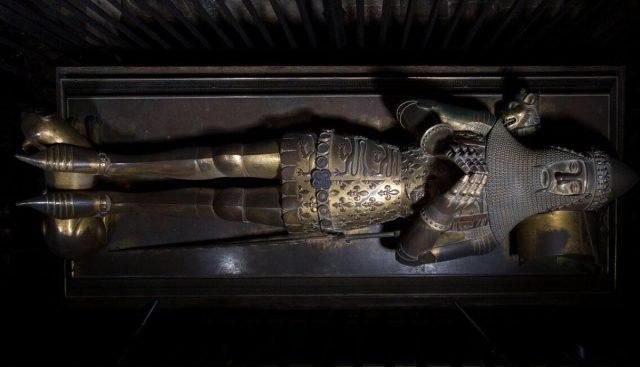
Visitors to Canterbury Cathedral can view the effigy of a 14th-century knight in full armor laid out on top of a marble tomb. It’s the tomb of Edward of Woodstock, colloquially known as the Black Prince, and it’s one of just six surviving large cast-metal sculptures from medieval England. Now, a team of researchers at The Courtauld Institute of Art has gotten the first glimpse inside the gilt-copper alloy effigy in 600 years, thanks to X-ray and medical imaging techniques. The researchers’ findings were recently published in The Burlington Magazine.
“Until now, a lack of documents about the Black Prince’s tomb and effigy has limited our understanding of their construction, chronology, and patronage. So our scientific study of them offers a long-overdue opportunity to reassess the effigy as one of the country’s most precious medieval sculptures,’ said co-author Jessica Barker, a medievalist at The Courtauld. “By using the latest scientific technology and closely examining the effigy, we have discovered so much more about how it was cast, assembled, and finished.”
Edward of Woodstock was the eldest son of King Edward III and heir apparent to the throne. He was educated in philosophy and logic and well-trained in the art of war—skills that proved useful in this particular period of the Hundred Years’ War, when invasion by the French was a constant threat. Edward’s first foray into battle was at the vanguard of the famous Battle of Crécy in 1346, when he was just 16. Beset by a dangerous counterattack, the young knight sent word to his father requesting reinforcements. Edward III refused to give in to protective paternal instincts, declining the request and insisting he wanted his son to “prove his spurs” in battle.
The young prince prevailed, launching an impressive military career. For instance, Edward distinguished himself at the 1350 Battle of Calais and later led an army into Aquitaine, where he and his men pillaged and plundered several towns. One of his biggest victories was the 1356 Battle of Poitiers, where he and his men routed the French army and captured King John II of France. He spent the next 10 years or so in Aquitaine, taking on the title of Prince of Aquitaine and Gascony (which most Gascon nobles refused to recognize).
Public domain.
Historians disagree about how he came to be called the Black Prince. The first known reference to Edward as the Black Prince is in two manuscript notes by the 16th-century poet and historian John Leland. Shakespeare refers to him as “that black name, Edward, Black Prince of Wales” in Henry V, written circa 1599, and includes a reference in Richard III (circa 1595). So the moniker was well established by the end of the 16th century.
One popular theory is that Edward wore black armor into battle; there is one French account describing him as being clad en armure noir en fer bruni (“in black armor of burnished steel”). But otherwise, the evidence for this is scant. The other hypothesis is that the name derives from Edward’s well-documented reputation for brutality in battle. In England, of course, he was lauded as the epitome of noble chivalry, but the French in Aquitaine held a very different view.

courtesy the Dean and Chapter of Canterbury
Edward may have been formidable in battle, but his health declined rapidly once he returned to England in 1371. He suffered from violent dysentery and sometimes fainted from the attacks. By this time, the prince was deeply in debt, thanks to his fondness for hosting lavish tournaments and showering friends with gifts. He was deep enough in the hole that, as he was preparing for one final military campaign, he asked King Edward III to ensure that, should he be killed, his debts would be paid out of his estate.
The Black Prince died on June 8, 1376, at the Palace of Westminster. Per the instructions in his deathbed will, he was buried in great state on September 29 in Canterbury Cathedral, with a gloomy epitaph on his tomb with the metal effigy. His father died the following year, and Edward’s 10-year-old son ascended the throne as Richard II. (Richard II, in turn, was deposed in 1399 by the exiled Henry Bolingbroke—son of the Black Prince’s younger brother, John of Gaunt, and another grandson of Edward III—who became Henry IV.)
Barker and her colleagues needed a nondestructive, portable method for analyzing the effigy’s metal composition, and they found it in a handheld X-ray fluorescence spectrometer. The process wasn’t easy, even with the handheld instrument, according to co-author Emily Pegues, currently a graduate student at The Courtauld. (Pegues is also an assistant curator of sculpture at the National Gallery of Art in Washington, DC). She posted several pictures on Twitter of the “acrobatics” required and expressed gratitude for having a solid scaffolding for support. The team used a simple videoprobe, commonly used in medicine, to peer into the Black Prince’s effigy.









